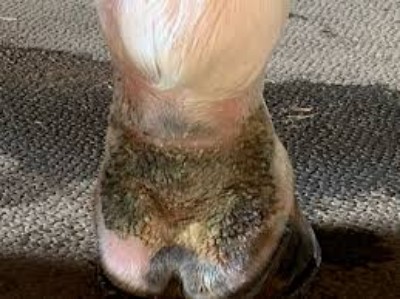This blog is based on MY experience and does not and should not replace veterinary advice. Please always consult your vet before commencing any treatment.
This time of the year, summer/Autumn, I am seeing a lot of posts on social media about mud fever and asking how to fix it.
You may have seen photos of my horse, he has 3 white legs to his knees. When I first got him, he had 3 very swollen, very sore legs. Just before I picked him up it had rained causing a flush in the grass which left him with really nasty photosensitivity. Crash course in how to deal with photosensitivity for me! The first thing I did was consult my vet. This should always be your first port of call. He prescribed some topical cream and steroids to help settle the painful skin and swelling. I then needed to learn how to stop it from reoccurring.
This time of the year, what people are describing as mud fever is unlikely to be mud fever and more likely to be photosensitivity. They both present with similar symptoms but are different conditions. They both need to be fixed from the inside out to prevent it from coming back. There is heaps on information on the internet on both conditions but very basically, mud fever is caused by wet conditions and bacteria, photosensitivity is caused by something the horse has eaten or come in contact with that makes them susceptible to sunburn.
**the same principals and suggestions in this blog can also be applied to mudfever with the exception of looking at what the horse is eating as a cause.
This is a great explanation of photosensitivity from Vetpro
There is a condition called photosensitisation, it is where even lightly pigmented (not just white) skin reacts abnormally to ultraviolet light and results in photodermatitis. Triggers for this can arise from exposure to a chemical that may create the skin to be more sensitive to UV light. These can be chemical based fly sprays, some coat conditioners some dyes and some drugs such as some antibiotics and tranquilisers.
Another source of photosensitisation is from some plants and weeds that are digested by the horse as they produce reactive compounds called photosensitisers or photodynamic agents which flow through to the skin and create greater sensitivity in the skin. These can be in some clovers, cow parsley, comfrey, St. John’s wort. Even contact with common buttercups can cause a localised irritation and sensitivity on the muzzle.
This condition can also be seen as a side effect of severe liver damage, as a poorly functioning liver doesn’t process chlorophyll efficiently resulting in phylloerythrin in the tissues of the horse. Liver damage can have varied causes but one is the ingestion of ragwort when it has been dried such as hay cut from an infested paddock.
The first thing people want to do is fix the visible cause, the scabs. There are many weird and wonderful home remedies that people will swear work, some which are downright harmful to the horse. I have seen such helpful suggestions as bleach, Napisan type products, oil-based products such as baby oil or a combination. All of which will irritate the skin and/or make it more susceptible to damage. Oil based products, while having the effect of softening the scabs, can exacerbate the burning from the sun. The scabs are sore and the skin is damaged and raw! Would you want caustic products like bleach put on to broken skin? Would you expect that to be beneficial in promoting healing? Your vet is the best person to advise what is the best topical treatment to help treat and soothe the scabs based on your horse’s presentation.
Treatment of the scabs is important but more important is preventing it from returning. Remember the scabs are only a symptom, not the cause. Is there something in the paddock you can identify that might be causing the issue? Is there something in the feed that could be an issue? Does your horse have an underlying condition that might be making them more susceptible? Do they have shade to be able to get out of the sun?
For my horse, grazing a lot of clover (a little bit is fine) and eating Lucerne hay are triggers. To help his system cope and prevent the photosensitivity from reoccurring, I did four things.
- I removed anything from his environment I thought might be causing the problem. I reintroduced one thing at a time to establish what were triggers. This is how I identified clover and Lucerne to be problematic for him.
- I initially put him on Echinacea to help boost his immune system. BetaVet Echinacea Premier is what I recommend
- I feed him a good toxin binder that helps him deal with flushes in the grass. I use Elite Equine Graze
- I feed him a good mineral supplement. Elite Equine Compete has proven results in helping horses recover from mud fever and photosensitivity, among other benefits. See photo below for results.
Now I have done those things, in the five years since I have had him, he has not had another major bout of photosensitivity nor has he had mud fever despite sometimes in the winter, the conditions being very wet and muddy. He will have the odd little scab appear if he gets too much clover but his system, now it has what it needs, deals with that quickly and quite nicely.
Again, this is based on MY experience and does not and should not replace veterinary advice. Please always consult your vet before commencing any treatment.



